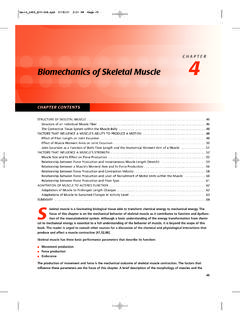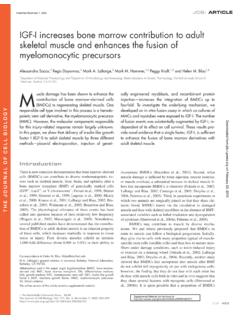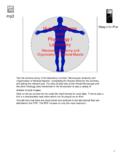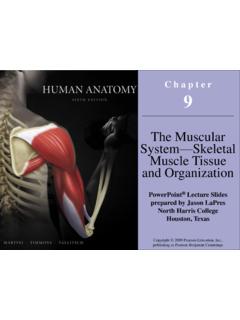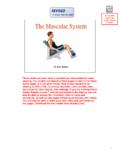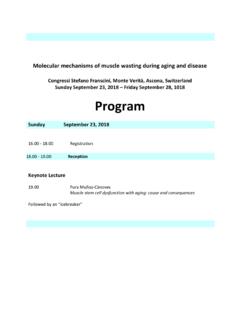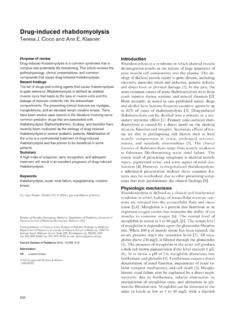Transcription of RESEARCH REPORT 316 - Health and Safety Executive
1 HSEH ealth & SafetyExecutiveMusculo- skeletal disorders, mental Health and the work environment Prepared by University of Oxford for the Health and Safety Executive 2005 RESEARCH REPORT 316 HSEH ealth & SafetyExecutiveMusculo- skeletal disorders, mental Health and the work environment Katharine R Parkes MA MSc PhD Susan Carnell BA, Elly Farmer BA Department of Experimental Psychology University of Oxford South Parks Road Oxford OX1 3UD The prevalence and severity of musculoskeletal disorders (MSD) were assessed in cross-sectional and longitudinal data obtained from male employees in the UK oil and gas industry.
2 The roles of the physical and psychosocial work environment, and of individual factors were examined in relation to reported MSD. Assessed by the Nordic Musculoskeletal Questionnaire (MSQ) (N=321), lower back pain showed thehighest 12-month prevalence rate (51%) but, taken together, neck, shoulders and/or upper back MSD had a similar prevalence rate. Mental Health , workload, physical environment stressors, and body mass index predicted MSD, although their relative importance varied across different body areas. In cross-sectional analyses (N=1462), relationships between psychosocial work measures and MSDin the neck/shoulders/back were mediated by psychological distress, but job activity level (strenuous, active, and sedentary) and physical stressors remained significant direct predictors.
3 The effect of negative affectivity on MSD was also mediated by psychological distress, particularly anxiety. In longitudinal analyses (N=321), anxiety and social support were significant factors predicting changein MSD over the five-year period, 1995-2000. In common with other published findings, the evidence suggested that the primary causal direction was from anxiety to MSD. Factor analysis identified three scales (stress/anxiety, work, and lifestyle) in a set of items assessingbeliefs about MSD causes (N=676). MSD problems were primarily attributed to work and lifestyle factors.
4 Individual experiences of MSD, including perceived causes and medical consultations, were also analysed. This REPORT and the work it describes were funded by the Health and Safety Executive (HSE). Its contents, including any opinions and/or conclusions expressed, are those of the authors alone and do not necessarily reflect HSE policy. HSE BOOKS Crown copyright 2005 First published 2005 ISBN 0 7176 2964 3 All rights reserved. No part of this publication may be reproduced, stored in a retrieval system, or transmitted in any form or by any means (electronic, mechanical, photocopying, recording or otherwise) without the prior written permission of the copyright owner.
5 Applications for reproduction should be made in writing to: Licensing Division, Her Majesty's Stationery Office, St Clements House, 2-16 Colegate, Norwich NR3 1BQ or by e-mail to ii INDEX 1. INTRODUCTION 1 Present study 3 2. PREVALENCE OF MUSCULO- skeletal COMPLAINTS 5 Nordic Musculoskeletal Questionnaire 5 Results 5 Comparison of present data with literature findings 15 3. ANALYSIS OF MSD SYMPTOMS IN NECK, SHOULDERS AND BACK 17 Data analysis 17 Overall prevalence rates and severity ratings 17 Differences in MSD prevalences across job types 18 MSD symptom reports in relation to GHQ caseness 19 Multivariate analyses 20 Severity of reported MSD problems 24 4.
6 CHANGE IN MUSCULO- skeletal DISORDERS, 1995 - 2000 27 Longitudinal analyses 27 Health -related measures in 1995 and 2000 27 Change in MSD ratings in relation to age and job type 29 Change in MSD ratings in relation to environmental and individual factors 29 Anxiety and MSD symptoms: patterns of change over time 31 Change in MSD in relation to change in overall Health ratings 34 5. GENERAL BELIEFS ABOUT THE CAUSES OF MSD 36 Assessment of general beliefs about the causes of MSD 36 Analysis of scale scores 36 6. INDIVIDUAL BELIEFS ABOUT THE CAUSES OF MSD 40 Data analysis 40 Identification of particular causes in relation to type of MSD 40 Comparison of perceived MSD causes across job types 40 Beliefs about MSD causes as related to personal factors 45 Medical consultations about MSD problems 46 Factors perceived to underlie absence of MSD problems 48 7.
7 CONCLUSIONS 49 MSD prevalences in the present sample 49 Individual and environmental factors as predictors of MSD 50 MSD and psychological distress: issues of causal direction 52 Beliefs about the causes of MSD 53 8. REFERENCES 55 iii iv 1. INTRODUCTION Musculo- skeletal disorders (MSD) are a major cause of disability in the working population. Government statistics indicate that MSD accounted for one quarter of claims for incapacity benefit in the UK in 1996 (Griffiths, 1998). Published RESEARCH data also confirm the high incidence of MSD. For instance, in a large-scale survey of a stratified random sample carried out in 1995, MSD accounted for 57% of the total those reporting work-related illness (Jones, Hodgson, & Osman, 1998).
8 Similarly, Houtman, Bongers, Smulders, & Kompier (1994), analysing data from a representative sample of the working population in the Netherlands, found that 25% reported back pain complaints, 8% chronic back problems, and 24% muscle and joint complaints. The roles of personal and environmental factors in relation to MSD, particularly lower back pain, have been widely examined in the medical, epidemiological, and psychological literature. Demographic variables (gender, age, socioeconomic status); physical work demands ( constrained posture, lifting, repetitive movements); and psychosocial work conditions (fast work pace, low discretion, role conflict) have all been implicated (eg.)
9 Engels, van der Beek, & van der Gulden, 1998; Leijon, Hensing, & Alexanderson, 1998; Hagen, Magnus, & Vetlesen, 1998; Palsson, Stromberg, Ohlsson, & Skerfving, 1998). Whilst much RESEARCH in this area is cross-sectional in design (eg. Friedrich, Cermak, & Heiller, 2000; Hagen et al., 1998; Joksimovic, Starke, von dem Knesebeck, & Siegrist, 2002; Piirainen, Rasanen, & Kivimaki, 2003; Rasanen, Notkola, & Husman, 1997; Toomingas, Theorell, Michesen, & Nordemar, 1997), a substantial number of prospective studies have also been reported ( Elders & Burdorf, 2004; Estlander, Takala, & Viikari-Juntura, 1998; Fredriksson, Alfredsson, Koster, Thorbjornsson, Toomingas, Torgen, & Kilbom, 1999; Maul, Laubli, Klipstein, & Krueger, 2003; Viikari-Juntura, Martikainen, Luukkonen, Mutanen, Takala, & Riihimaki, 2001).
10 Example of two recent prospective studies illustrate typical findings. Thus, Eriksen, Bruusgaard, and Knardahl (2004) ) studied a large sample of Health -care workers over a 15-month period; the findings showed that Not only frequent mechanical exposures, but also organisational, psychological, and social work factors, such as night shift work, perceived lack of support from superior, and perceived lack of pleasant and relaxing or supporting and encouraging culture in the work unit, are associated with an increased risk of intense low back pain (LBP) symptoms and LBP-related sick leave in nurses aides ( ).










